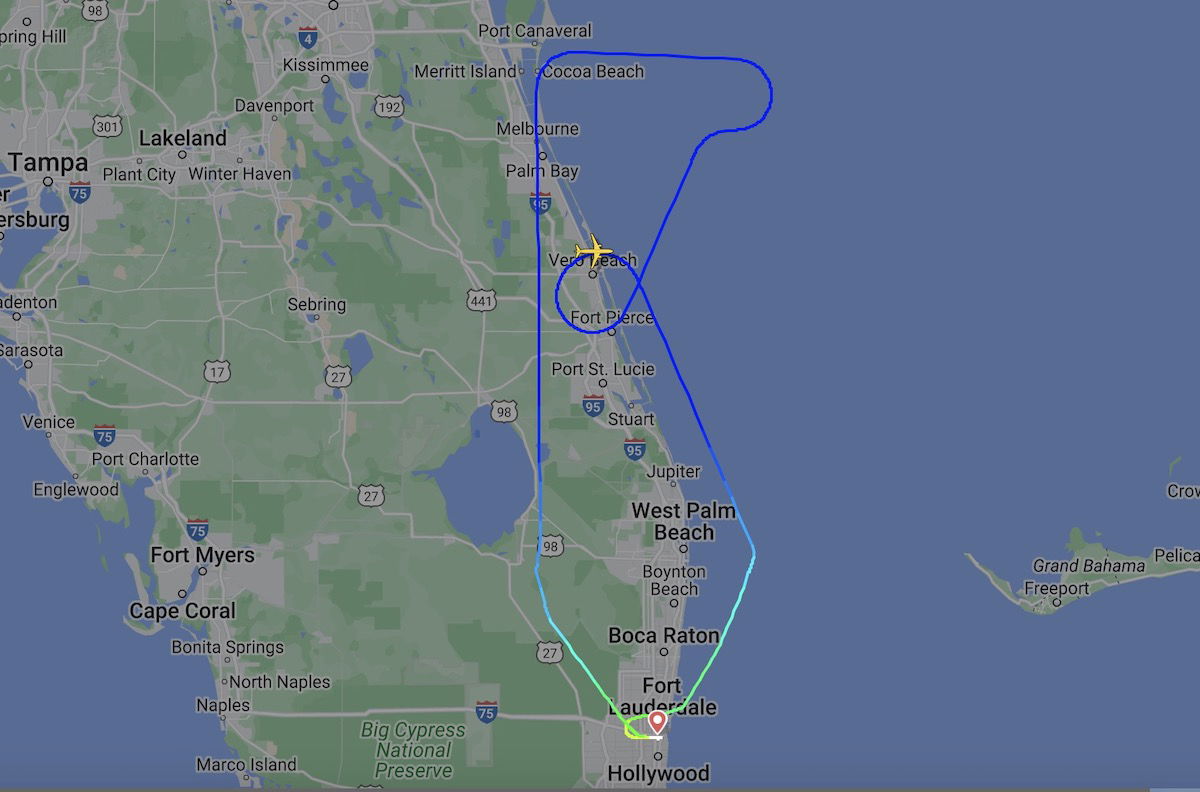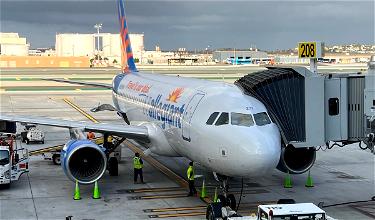A recent Allegiant flight had to return to its origin shortly after takeoff, after a flight attendant was injured. However, it’s not for the reason you might assume.
In this post:
Allegiant pilots take “evasive action” to avoid collision
This incident happened on Sunday, July 23, 2023, and involves Allegiant Air flight G4485, scheduled to fly from Fort Lauderdale (FLL) to Lexington (LEX). The flight was operated by a 26-year-old Airbus A320 with the registration code N229NV.
Anyway, the aircraft departed on the 865-mile flight as planned, and initially climbed up to 23,000 feet. Air traffic controllers had instructed the plane to turn eastbound right near Port Canaveral, Florida, though at that point the plane was put directly in the path of a northbound Gulfstream jet that was at the same altitude.
The pilots of the Allegiant flight received an automated alert about close proximity to another aircraft, so the pilots took “evasive action” (as the FAA describes it) to avoid collision. This incident is now being investigated, and suffice it to say that this was a really close call, as you’ll see in the below animation.
The flight tracking animation doesn’t show any drastic turns, but rather shows the aircraft briefly climbing steeply to avoid a collision.
Allegiant flight attendant gets injured, causing diversion
While all the passengers were still seated when this incident happened, the flight attendants were starting their inflight service. Unfortunately this unexpected maneuver caused a flight attendant to be seriously injured.
NBC conducted an interview with a 21-year-old woman who was onboard the flight. Here’s how she described the flight attendant injuries:
“Two of the flight attendants that were handing out drinks at the time, they both fell to the ground. One of them was completely fine. But the other one did hit her head on her hand row, and it also turns out that she snapped her wrist.”
“She was crying. She laid on the ground for at least five minutes before they picked her up and moved her toward the back of the plane, and about five more minutes after that, they asked if there was any medically trained person on the airplane, when they finally got a woman and brought her back with them.”
This same passenger reported that she initially wasn’t too alarmed, and had assumed it was turbulence, which they were warned about before the flight:
“In the pre-flight announcement, they let us know that there was going to be some turbulence because there was a storm up north, so we were kind of expecting a rough flight. About 20 minutes into the flight, the stewardesses were beginning to take orders and hands out drinks, when, all of a sudden, it felt like we were going down.”
“I felt the plane actually make its turn to go back toward Fort Lauderdale. About 15 minutes later, the pilot comes back on the intercom, and he says, ‘Unfortunately, we have turned back toward Fort Lauderdale. I had to make an abrupt maneuver to avoid another aircraft.'”
With a flight attendant injured, the decision was made to return to Fort Lauderdale. The flight ended up spending a total of around 65 minutes in the air prior to its return.

Bottom line
An Allegiant Air A320 had to return to Fort Lauderdale after a flight attendant sustained injuries. For once it wasn’t due to severe turbulence or due to passenger aggression, but rather was due to a maneuver that pilots performed after their traffic alert system went off.
This is an important reminder to always keep your seatbelt fastened when seated, because it can help prevent serious injuries. I’m curious to see what comes of the FAA investigation, regarding which party messed up here to cause such a close call.
What do you make of this Allegiant A320 incident?





Why would Miami direct them to turn east out into the Atlantic when heading to Lexington? Did the controller confuse east/west and turn them into path of the Gulfstream?
Definitely listen and obey TCAS.
https://en.wikipedia.org/wiki/2002_%C3%9Cberlingen_mid-air_collision
FAA Commercial Helicopter pilot here. When TCAS says "traffic" we move laterally and downward. Odds are that keeps us away and away from that traffic.
Some human error along the chain of events which is preventable by automation.
I can assure you automation used on aircraft and ATC is incredibly flawed. Only reason we don't have disaster very often is humans.
You might as well just give up on this line of commentary (that you seem to share whenever Aviation blunders are discussed). What you're after won't be happening in our lifetime. For better or worse.
You seem to think we should replace 10s of thousands of people and put them out on the streets to avert some hypothetical future disaster. When considering that automation still requires trial and error that may lead to disaster, your...
You might as well just give up on this line of commentary (that you seem to share whenever Aviation blunders are discussed). What you're after won't be happening in our lifetime. For better or worse.
You seem to think we should replace 10s of thousands of people and put them out on the streets to avert some hypothetical future disaster. When considering that automation still requires trial and error that may lead to disaster, your ideology may actually be much more harmful than helpful.
Do the words Allegiant and Medically Trained even go together?
Always listen to TCAS.
TCAS 2024 for President.
Descend! Descend!
Descend now ! Descend now !
Climb ! Climb !
Climb now ! Climb now !
This is exactly how bad information makes it across the internet. @lucky. At this point of the investigation … How do you know why the pilots made any kind of maneuver. Was it a traffic alert with a reaction after visual contact or a TCAS RA. Now I’m not going to fly someone else’s airplane but I’ve had several RAs throughout my career and never do they require any harsh reactions . In addition …...
This is exactly how bad information makes it across the internet. @lucky. At this point of the investigation … How do you know why the pilots made any kind of maneuver. Was it a traffic alert with a reaction after visual contact or a TCAS RA. Now I’m not going to fly someone else’s airplane but I’ve had several RAs throughout my career and never do they require any harsh reactions . In addition … flight radar 24 is really bad for giving technical explanations as to how an airplane maneuvered.
This blog run by what is the best points and miles blogger turns into CNN when it goes off topic. Let’s wait to see what the NTSB says.
@ SMR -- I'm only reporting what the FAA's statement claims. Here's the statement:
"Allegiant Air Flight 485, an Airbus A320, took evasive action on Sunday, July 23, after the pilot received an automated alert about another aircraft at the same altitude. An air traffic controller in the Miami Air Route Traffic Control Center had instructed Flight 485 to turn eastbound at an altitude of 23,000 feet when it crossed in front of a...
@ SMR -- I'm only reporting what the FAA's statement claims. Here's the statement:
"Allegiant Air Flight 485, an Airbus A320, took evasive action on Sunday, July 23, after the pilot received an automated alert about another aircraft at the same altitude. An air traffic controller in the Miami Air Route Traffic Control Center had instructed Flight 485 to turn eastbound at an altitude of 23,000 feet when it crossed in front of a northbound Gulfstream business jet. The pilot of the Gulfstream also took evasive action after receiving a similar alert. Flight 485 returned to Fort Lauderdale International Airport, where a flight attendant was treated for injuries."
So to answer your questions:
"How do you know why the pilots made any kind of maneuver" -- because the FAA said so
"Was it a traffic alert with a reaction after visual contact or a TCAS RA" -- according to the FAA, it was a TCAS RA
If you think I got any details wrong, please by all means let me know, as I'm always looking to learn. :-)
@lucky. There are two levels of TCAS automated alerts.
1. Traffic, Traffic! is usually the first aural alert.
2. An RA or Resolution Advisory may follow and is when you get a climb or descent command. In an Airbus A320 your vertical speed indicator gets a green band in which you must establish. It is safe to say you have a few seconds to get into that band, it's not an instant snap...
@lucky. There are two levels of TCAS automated alerts.
1. Traffic, Traffic! is usually the first aural alert.
2. An RA or Resolution Advisory may follow and is when you get a climb or descent command. In an Airbus A320 your vertical speed indicator gets a green band in which you must establish. It is safe to say you have a few seconds to get into that band, it's not an instant snap up or down but not much decision making is required. click off autopilot and pitch into the green band. It is supposed to give you enough time to react.
I do not see anything in the FAA report stating that pilots reacted to an RA. Not saying they did not, but there are other scenarios possible. We do not know exactly how close this was...exactly what the flight crew saw to react more abrasively then a normal RA and I am just saying Flight Radar 24 is better to get a general idea of vertical and horizontal flights paths and not exact data that can help in assessing how pilots reacted to a specific scenario.
But there is also an expedite decent/climb command if their initial decent/climb isn’t sufficient to clear the traffic.
You can also get secondary RAs , especially in congested airspace.
I'd give Lucky more credit than CNN, but the problem with any commentary/article on ATC matters is that it's exceptionally hard to judge... whether you're an outsider or an insider.
For instance, on our last time around we were discussing a double UA go-around at SFO. Everybody and their moms... whether it was on Ben's article, on the YouTube breakdown... or even in ATC forums... concluded that "that controller" was incompetent/should be fired/should have to...
I'd give Lucky more credit than CNN, but the problem with any commentary/article on ATC matters is that it's exceptionally hard to judge... whether you're an outsider or an insider.
For instance, on our last time around we were discussing a double UA go-around at SFO. Everybody and their moms... whether it was on Ben's article, on the YouTube breakdown... or even in ATC forums... concluded that "that controller" was incompetent/should be fired/should have to pay for the fuel. Literally hundreds of comments critiquing "that controller".
Only a few people (self included) recognized that it was actually two different controllers... which could lend explanation to why it happened the way it did.
Why are you such a rude person? I think we need an alert to never read your comments.
If you look at the descent rate of the flight it is a 1664 fpm in a rather abrupt change, so while the pilot did not turn to avoid, he did descent rather quickly and suddenly.
eTCAS RA's never involve a turn. They also do not require pilots to push the nose up or down at rates that could hurt people.
Looks like the Gulfstream turned toward the A320 at the last second, probably setting off the ACAS.
I’m curious… who was on that Gulfstream, and did they notice anything, and why did they turn?